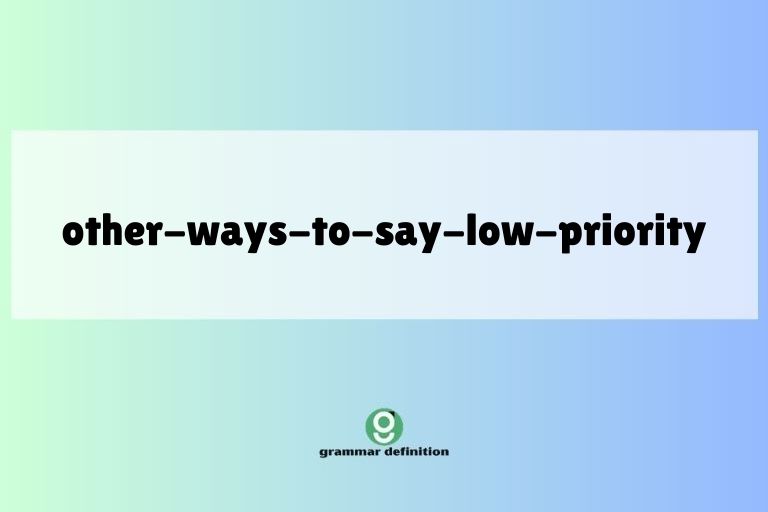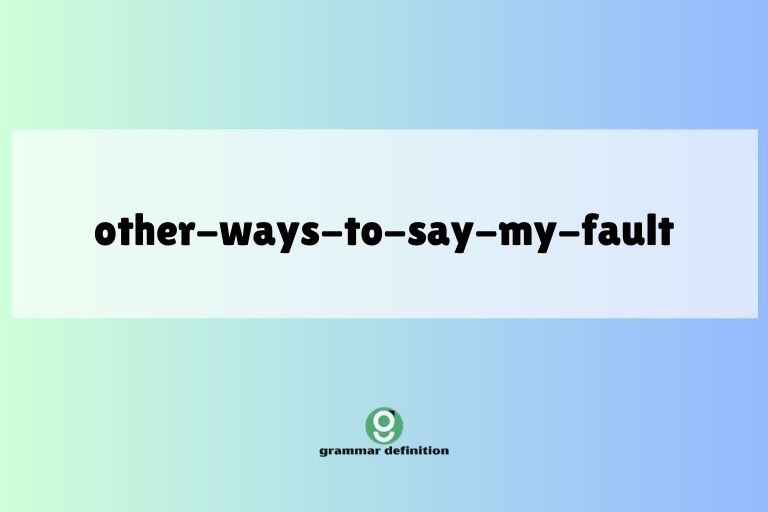Other Ways to Say “Low Priority”: Expanding Your Lexicon

Effective communication requires a nuanced understanding of language, especially when conveying the subtle gradations of importance. Simply stating something is “low priority” can sometimes sound dismissive or lack the necessary context.
This article explores a rich array of alternative phrases that capture the concept of low priority with greater precision and sensitivity. Whether you’re managing projects, delegating tasks, or simply expressing your opinions, mastering these alternatives will enhance your communication skills and ensure your message is received as intended.
This guide is designed for English language learners, professionals seeking to refine their communication, and anyone aiming to expand their vocabulary.
By understanding the nuances of these expressions, you can more effectively communicate the relative importance of tasks, projects, or ideas. This not only improves clarity but also fosters better working relationships and reduces the potential for misunderstandings.
Dive in to discover a wealth of options to express “low priority” in various contexts.
Table of Contents
- Introduction
- Definition of “Low Priority”
- Structural Breakdown of Alternatives
- Types and Categories of Alternatives
- Examples of Alternatives
- Usage Rules and Considerations
- Common Mistakes
- Practice Exercises
- Advanced Topics
- Frequently Asked Questions
- Conclusion
Definition of “Low Priority”
“Low priority” signifies that something is considered less important or urgent compared to other tasks, projects, or considerations. It implies that the item in question can be addressed later, with less immediate attention, or potentially even be disregarded if resources are limited.
The classification of an item as “low priority” is often relative, depending on the specific context and the competing demands for time, resources, and attention. Understanding the nuances of “low priority” is crucial for effective time management, project planning, and overall organizational efficiency.
In essence, “low priority” serves as a signal indicating that a particular item does not require immediate action and can be safely postponed or delegated to a later time. This allows individuals and organizations to focus their efforts on more critical tasks and objectives, ensuring that resources are allocated effectively and that key priorities are addressed promptly.
Structural Breakdown of Alternatives
Alternatives to “low priority” can be categorized based on their grammatical structure. These structures typically involve adjectives, adverbs, and prepositional phrases that modify nouns or verbs to convey the reduced level of importance.
Here’s a breakdown:
- Adjectives: These directly describe the noun, indicating its low priority status. Examples include “secondary,” “minor,” “peripheral,” and “inconsequential.”
- Adverbs: These modify verbs or adjectives, indicating that an action or quality is of low priority. Examples include “secondarily,” “marginally,” and “peripherally.”
- Prepositional Phrases: These phrases provide context and further specify the low priority nature of something. Examples include “of secondary importance,” “on the back burner,” and “lower down the list.”
- Verbal Phrases: These can also be used to express a low priority status, often involving verbs like “defer,” “postpone,” or “shelve.” For example, “to be deferred,” “to be postponed,” or “to be shelved.”
Understanding these structural elements allows you to create a wide range of alternative expressions, adapting your language to the specific context and desired level of formality. Furthermore, mastering this breakdown allows for a better understanding of how these alternatives function within sentences and how the grammatical structure influences the overall meaning.
Types and Categories of Alternatives
To better understand the various alternatives to “low priority,” we can categorize them based on the specific nuance they convey. These categories include expressions of deferral, lower importance, non-essential nature, later consideration, and minimal urgency.
Expressions of Deferral
These phrases suggest that the task or item is being postponed to a later time. They emphasize the act of delaying action rather than the inherent importance of the item itself.
Expressions of Lower Importance
These phrases explicitly state that the task or item is less important than other competing priorities. They directly address the relative significance of the item.
Expressions of Non-Essential Nature
These phrases indicate that the task or item is not crucial or necessary for the overall success of the project or objective. They highlight the dispensable nature of the item.
Expressions of Later Consideration
These phrases suggest that the task or item will be reviewed and addressed at a later point in time, without specifying a particular timeframe. They emphasize the intention to revisit the item in the future.
Expressions of Minimal Urgency
These phrases convey that there is no immediate need to address the task or item. They highlight the lack of time pressure associated with the item.
Examples of Alternatives
Here are several examples of phrases that can be used instead of “low priority,” organized by the categories discussed above. Each example is presented in a sentence to illustrate its proper usage.
Deferral Examples
The following table provides examples of phrases that express deferral, along with example sentences demonstrating their usage.
| Phrase | Example Sentence |
|---|---|
| To be deferred | This task is to be deferred until next quarter due to budget constraints. |
| Postponed until further notice | The meeting regarding the new marketing strategy has been postponed until further notice. |
| Put on hold | All new initiatives have been put on hold while we focus on the core business. |
| Suspended temporarily | The project has been suspended temporarily due to unforeseen circumstances. |
| Shelved for the time being | The proposal has been shelved for the time being as we reassess our priorities. |
| Parked for now | Let’s park this for now and revisit it later when we have more information. |
| Delayed | Implementation of the new software has been delayed until the next fiscal year. |
| Set aside | We’ve decided to set aside this issue for now and concentrate on more pressing matters. |
| On the back burner | That project is on the back burner while we deal with this crisis. |
| Tabled for later | The discussion about the budget was tabled for later in the meeting. |
| Put off | We had to put off the decision until more data was available. |
| Rescheduled | The appointment was rescheduled to a later date. |
| Pushed back | The deadline was pushed back due to unforeseen delays. |
| Held over | The item was held over until the next meeting for further review. |
| Left for another day | We’ll have to leave that for another day; we’re out of time. |
| Deferred to a later stage | The decision was deferred to a later stage of the project. |
| Put in abeyance | The application was put in abeyance pending further investigation. |
| Adjourned | The meeting was adjourned until next week. |
| Remanded | The case was remanded for further consideration. |
| Suspended indefinitely | The program was suspended indefinitely due to lack of funding. |
| Mothballed | The project has been mothballed due to the economic downturn. |
| Frozen | Hiring was frozen across the company. |
| Paused | The campaign was paused to allow for adjustments. |
| Delayed indefinitely | The launch was delayed indefinitely due to technical issues. |
Lower Importance Examples
The following table showcases alternatives that explicitly convey a lower level of importance compared to other tasks.
| Phrase | Example Sentence |
|---|---|
| Secondary | This task is of secondary importance compared to the main objective. |
| Of lesser priority | Addressing this issue is of lesser priority at the moment. |
| Less critical | This component is less critical to the overall system performance. |
| Lower down the list | This request is lower down the list of priorities. |
| Not a top priority | While important, this isn’t a top priority right now. |
| Subsidiary task | This is a subsidiary task, so focus on the main goals first. |
| Supplementary | The documentation is supplementary and not required for initial use. |
| Of minor importance | This detail is of minor importance to the overall project. |
| Less significant | This change is less significant than the previous modifications. |
| Of peripheral interest | The topic is of peripheral interest to the main discussion. |
| Lower-ranking | This is a lower-ranking concern compared to the urgent issues. |
| Less pressing | This matter is less pressing than the immediate deadlines. |
| Of reduced importance | This feature is of reduced importance in the current release. |
| Of diminished significance | The error is of diminished significance due to the workaround. |
| Less vital | This component is less vital for the core functionality. |
| Subordinate | This is a subordinate task and can be delegated. |
| Of secondary concern | This issue is of secondary concern at this stage. |
| Of tertiary importance | This is of tertiary importance and can be addressed last. |
| Less crucial | This step is less crucial for the initial setup. |
| Of lower stature | This matter is of lower stature within the organization. |
| Of inferior rank | This concern is of inferior rank compared to the leading issues. |
| Of reduced urgency | This is of reduced urgency and can be managed later. |
| Less immediate | The need is less immediate than other requirements. |
| Of smaller weight | This concern is of smaller weight in the overall decision. |
Non-Essential Examples
This table lists phrases that emphasize the non-essential nature of a task or item.
| Phrase | Example Sentence |
|---|---|
| Non-essential | This feature is non-essential for the initial release. |
| Optional | This step is optional and can be skipped if necessary. |
| Not required | This document is not required for the application process. |
| Dispensable | This component is dispensable without affecting core functionality. |
| Not mandatory | Attendance is not mandatory for this workshop. |
| Superfluous | This information is superfluous and doesn’t need to be included. |
| Unnecessary | This measure is unnecessary in the current circumstances. |
| Expendable | This resource is expendable if budget cuts are needed. |
| Not vital | This element is not vital to the success of the project. |
| Inessential | This detail is inessential and can be omitted. |
| Complementary | This is complementary but not a necessity. |
| Additional | The software is additional and not required for basic tasks. |
| Elective | This course is elective and not part of the core curriculum. |
| Auxiliary | The equipment is auxiliary and only used for advanced procedures. |
| Non-compulsory | This training is non-compulsory for employees. |
| Not critical | This step is not critical for the initial setup. |
| Unimportant | This detail is unimportant at this stage. |
| Minor | This change is minor and won’t affect the overall process. |
| Inconsequential | This error is inconsequential and can be ignored. |
| Negligible | The impact is negligible and doesn’t warrant immediate action. |
| Non-essential addition | The feature is a non-essential addition for the basic version. |
| Nice-to-have | This is a nice-to-have but not a necessity. |
| Non-fundamental | This element is non-fundamental to the system’s operation. |
| Non-primary | This is a non-primary concern for now. |
Later Consideration Examples
This table presents phrases that suggest a task or item will be addressed at a later time.
| Phrase | Example Sentence |
|---|---|
| To be addressed later | This issue is to be addressed later in the project timeline. |
| To be reviewed later | The data will be reviewed later when more information is available. |
| For future consideration | This suggestion is noted for future consideration. |
| In due course | This matter will be addressed in due course. |
| At a later stage | This feature will be implemented at a later stage. |
| Down the line | We’ll look at that down the line. |
| In the future | We will address that in the future. |
| Subsequently | This will be handled subsequently. |
| In time | We will get to that in time. |
| At a later date | We will revisit this at a later date. |
| Afterwards | We’ll take care of that afterwards. |
| In the fullness of time | This issue will be resolved in the fullness of time. |
| In the long run | We’ll consider it in the long run. |
| Eventually | We’ll get to it eventually. |
| Sometime in the future | We’ll tackle this sometime in the future. |
| At a subsequent time | This will be addressed at a subsequent time. |
| Further down the road | We’ll look at that further down the road. |
| In the coming days | We will address this in the coming days. |
| In the coming weeks | We will address this in the coming weeks. |
| In the coming months | We will address this in the coming months. |
| As time allows | We will address this as time allows. |
| When resources are available | We will address this when resources are available. |
| When feasible | We will address this when feasible. |
| Upon further review | This will be addressed upon further review. |
Minimal Urgency Examples
This table provides examples of phrases suggesting there is no immediate need to address the task or item.
| Phrase | Example Sentence |
|---|---|
| Not urgent | This task is not urgent and can wait. |
| No immediate need | There is no immediate need to address this issue. |
| Can wait | This can wait until next week. |
| No rush | There’s no rush to complete this task. |
| Not time-sensitive | This matter is not time-sensitive. |
| Can be done later | This can be done later when we have more time. |
| At your convenience | Complete this task at your convenience. |
| When you have time | Address this when you have time. |
| Take your time | There’s no need to hurry; take your time. |
| No deadline | There is no deadline for this task. |
| Non-critical timeline | This task has a non-critical timeline. |
| Minimal time pressure | There’s minimal time pressure on this project. |
| Leisurely pace | We can proceed at a leisurely pace. |
| Not a pressing matter | This is not a pressing matter at the moment. |
| Relaxed schedule | We have a relaxed schedule for this task. |
| Can be handled at one’s leisure | This can be handled at one’s leisure. |
| Not a priority at this juncture | This is not a priority at this juncture. |
| No specific timeframe | There’s no specific timeframe for completion. |
| Can be addressed when convenient | This can be addressed when convenient. |
| When the opportunity arises | This will be addressed when the opportunity arises. |
| At a more opportune moment | This will be addressed at a more opportune moment. |
| When circumstances allow | This will be addressed when circumstances allow. |
| When conditions are favorable | This will be addressed when conditions are favorable. |
| When the situation permits | This will be addressed when the situation permits. |
Usage Rules and Considerations
When choosing an alternative to “low priority,” consider the context, your audience, and the specific nuance you want to convey. Some phrases are more formal than others, and some are more direct.
For instance, “shelved for the time being” might be appropriate in an internal memo, while “of lesser priority” might be better suited for a client communication. Always strive for clarity and avoid language that could be misinterpreted.
Furthermore, be mindful of the potential impact of your words. Even when something is genuinely a low priority, it’s important to communicate this in a way that doesn’t sound dismissive or devaluing.
Consider framing your message positively, emphasizing the importance of other tasks rather than simply downplaying the one in question. For example, instead of saying “This is a low priority,” you could say “Let’s focus on X first, and then we can address this.”
Common Mistakes
One common mistake is using overly informal or colloquial language in professional settings. While phrases like “put on the back burner” are perfectly acceptable in casual conversation, they may not be appropriate for formal reports or client presentations.
Another mistake is being too vague or ambiguous. If you simply say something is “not important,” without providing any context or explanation, it can lead to confusion and frustration.
Always be specific and provide clear reasons for your prioritization decisions.
Another frequent error involves using alternatives that don’t accurately reflect the situation. For example, using “postponed” when the task is actually considered unnecessary can be misleading.
Ensure that the phrase you choose aligns with the true status and importance of the item in question.
| Incorrect | Correct | Explanation |
|---|---|---|
| This is totally unimportant. | This is of minor importance compared to our primary goals. | Replaces informal language with a more professional tone. |
| We’ll get to it eventually. | We will address this issue at a later stage of the project. | Provides a more specific and professional timeframe. |
| Just forget about it. | Let’s defer this task until we have more resources. | Offers a reason for the deferral instead of dismissiveness. |
| This isn’t a big deal. | This is less critical than the urgent deadlines we are facing. | Clarifies the relative importance in comparison to other tasks. |
| We’ll do it whenever. | This can be completed at your convenience. | Replaces vagueness with a clear indication of flexibility. |
Practice Exercises
Test your understanding of the alternatives to “low priority” with the following exercises. Choose the most appropriate phrase from the list provided to replace “low priority” in each sentence.
Phrases: postponed until further notice, of lesser priority, non-essential, for future consideration, not urgent
| Question | Answer |
|---|---|
| 1. This task is currently a ______ task, as our main focus is on completing the project’s core objectives. | of lesser priority |
| 2. Due to budget constraints, the implementation of the new marketing campaign has been ______. | postponed until further notice |
| 3. This feature is considered ______ for the initial release of the software; it can be added in a later update. | non-essential |
| 4. Your suggestion for improving team communication has been noted ______, and we will revisit it during our next planning session. | for future consideration |
| 5. Completing this report is ______, so there is no need to rush; you can submit it when you have the time. | not urgent |
| 6. The upgrade to the office furniture is ______ as the company focuses on more critical aspects of operations. | of lesser priority |
| 7. The decision on the new vendor has been ______ due to the ongoing negotiations. | postponed until further notice |
| 8. The additional training module is considered ______ for new hires and will not be required for the basic certification. | non-essential |
| 9. The proposal for a new company event is filed ______ for the next budget cycle. | for future consideration |
| 10. The completion of the survey is ______ and can be completed at the employees’ leisure. | not urgent |
Exercise 2: Rewrite the following sentences using a more appropriate alternative to “low priority.”
| Question | Answer |
|---|---|
| 1. This issue is low priority, so don’t worry about it for now. | This issue can be addressed at a later date when resources are available. |
| 2. That task is low priority; do the important stuff first. | That task is of lesser priority; focus on the critical tasks first. |
| 3. The update is low priority; we can wait to install it. | The update is not urgent and can be installed at your convenience. |
| 4. Fixing that bug is low priority; it’s not affecting anyone. | Fixing that bug is non-essential as it’s not affecting users. |
| 5. The suggestion box is low priority; we’ll look at it later. | The suggestions in the suggestion box are for future consideration. |
| 6. The report’s edits are low priority because there are other urgent tasks. | The report’s edits are of lesser priority due to other urgent tasks. |
| 7. The project update is low priority; we will wait until next week to discuss it. | The project update is postponed until next week’s meeting. |
| 8. The new software installation is low priority, so it is not essential during the initial setup. | The new software installation is non-essential and not required during the initial setup. |
| 9. Your feedback is low priority; we will consider it later when we have more time. | Your feedback is noted for future consideration and will be reviewed when time allows. |
| 10. The survey completion is low priority, so complete it in your own time. | The survey completion is not urgent, so complete it at your convenience. |
Advanced Topics
For advanced learners, consider exploring the subtle differences in connotation between various alternatives. For example, “tabled” might suggest a temporary delay, while “shelved” could imply a more indefinite postponement.
Additionally, explore the use of conditional clauses to soften the impact of conveying low priority. For example, instead of saying “This is not a priority,” you could say “This will become a priority once we complete the initial phase.”
Furthermore, consider the cultural context. In some cultures, directness is valued, while in others, a more indirect approach is preferred.
Adapt your language accordingly to ensure effective and respectful communication. Understanding these nuances will enhance your ability to navigate complex communication scenarios and build strong relationships with colleagues and clients.
Frequently Asked Questions
- What’s the best way to tell someone their task is “low priority” without sounding dismissive?
Frame it positively by emphasizing the importance of other tasks. Explain the reasons for the prioritization and offer a realistic timeline for when the task might be addressed. For example, “To ensure we meet the deadline for Project X, let’s focus on tasks A, B, and C first. We can revisit your task as soon as we’ve made significant progress on those.” This approach acknowledges the task’s value while providing context for its current status.
- How do I decide which alternative to “low priority” is most appropriate?
Consider the context, your audience, and the specific nuance you want to convey. If you want to emphasize that the task is being postponed, use phrases like “postponed until further notice” or “shelved for the time being.” If you want to highlight its relative importance, use phrases like “of lesser priority” or “less critical.” Choose the phrase that most accurately reflects the situation and avoids any potential misunderstandings.
- Is it ever okay to simply say something is “low priority”?
Yes, in some situations, directness is appropriate, especially in internal communications where there’s a high level of trust and transparency. However, even in these cases, it’s helpful to provide context and explain the reasons for the prioritization. Avoid using the phrase in situations where it could be perceived as rude or dismissive.
- How can I avoid misunderstandings when communicating low priority?
Be clear, specific, and provide context. Avoid vague or ambiguous language. Explain the reasons for the prioritization and offer a realistic timeline for when the task might be addressed. Use language that is respectful and avoids sounding dismissive or devaluing. Always be open to questions and clarification.
- What if someone disagrees with my assessment of a task as “low priority”?
Listen to their concerns and try to understand their perspective. Explain your reasoning clearly and provide evidence to support your assessment. Be willing to compromise if possible, but ultimately, make the decision that is in the best interest of the overall project or organization. Document your decision and the reasons behind it to avoid future misunderstandings.
- How do I handle tasks that are consistently labeled as “low priority” but are still important in the long run?
Schedule dedicated time for these tasks, even if it’s just a small amount each week. Break down larger tasks into smaller, more manageable steps. Delegate tasks whenever possible. Regularly reassess the priority of these tasks to ensure they don’t get overlooked. Communicate the importance of these tasks to your team and stakeholders.
- What are some signs that I’m overusing the term “low priority” or its alternatives?
If tasks consistently get postponed or ignored, if team members express frustration or feel devalued, or if important long-term goals are being neglected, it’s a sign that you may be overusing the term or mismanaging priorities. Re-evaluate your prioritization process and ensure that all tasks are being given fair consideration.
- How can I improve my prioritization skills?
Start by clearly defining your goals and objectives. Identify the tasks that are most critical to achieving those goals. Use a prioritization matrix to rank tasks based on their importance and urgency. Regularly reassess your priorities and adjust as needed. Seek feedback from your team and stakeholders. Continuously learn and refine your prioritization process.
Conclusion
Mastering alternatives to “low priority” is a valuable skill for anyone seeking to improve their communication and leadership abilities. By understanding the nuances of these expressions, you can more effectively convey the relative importance of tasks, projects, and ideas, fostering better working relationships and reducing the potential for misunderstandings
, and improving overall team morale.
This expanded vocabulary allows you to communicate with greater precision and sensitivity, ensuring that your message is received as intended and that important tasks are not overlooked. Embrace these alternatives and elevate your communication skills to new heights.






